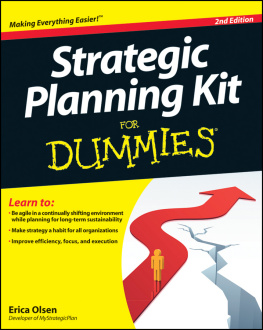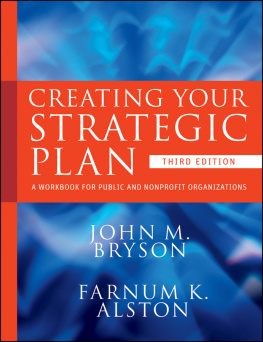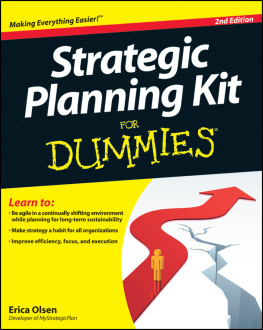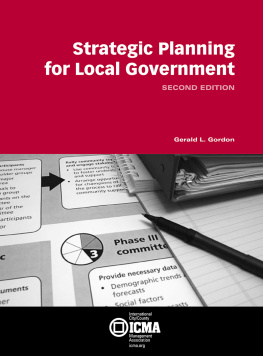The Rise and Fall of Strategic Planning
Copyright 1994 by Henry Mintzberg
All rights reserved. No part of this book may be reproduced or transmitted in any form or by any means, electronic or mechanical, including photocopying, recording, or by any information storage and retrieval system, without permission in writing from the Publisher.
The Free Press
A Division of Simon & Schuster Inc.
1230 Avenue of the Americas
New York, N.Y. 10020
www.SimonandSchuster.com
Printed in the United States of America
printing number
20 19 18 17 16 15 14 13
Library of Congress Cataloging-in-Publication Data
Mintzberg, Henry.
The rise and fall of strategic planning: reconceiving roles for planning, plans, planners / Henry Mintzberg.
p. cm.
Includes bibliographical references and index.
ISBN-13: 978-0-029-21605-7
eISBN-13: 978-1-439-10735-5
1. Strategic planning. I. Title.
HD30.28.M56 1994
658.4012dc20 93-27323
CIP
Credits
The author and publisher of this volume wish to acknowledge the following sources for material:
From H. I. Ansoff, Corporate Strategy (McGraw-Hill, 1965). Excerpts and diagrams used with permission of the author.
From H. I. Ansoff, Implanting Strategic Management, 1984. Reprinted by permission of Prentice Hall, Englewood Cliffs, New Jersey.
Reproduced from The Politics of Expertise by A. Benveniste (Glendessary Press, 1972) with the permission of South-Western Publishing Co. Copyright 1972 by South-Western Publishing Co. All rights reserved.
From Joseph L. Bower, Managing the Resource Allocation Process: A Study of Corporate Planning and Investment. Boston: Division of Research, Harvard Business School, 1970. Reprinted as a Harvard Business School Classic. Boston: Harvard Business School Press, 1986.
From A Behavioral Theory of the Firm by R. M. Cyert and J. G. March (Prentice Hall, 1963; revised edition, 1992). Reprinted with permission of R. M. Cyert.
From Planning in Practice: Essays in Aircraft Planning in War-Time by E. Devons (Cambridge University Press, 1950). Reprinted with permission from Cambridge University Press.
Diagram from Strategic Management: A Stakeholder Approach by R. E. Freeman (Pitman Publishing, 1984). Reprinted with the permission of author.
From Organizing Competitor Analysis Systems by S. Ghoshal and D. E. Westney (Strategic Management Journal, 1991, 12:17-31). Reprinted with permission.
From Institutionalizing Innovation by M. Jelinek, pp. 136-141. 1979 by Marian Jelinek. Published 1979 by Praeger Publishers, an imprint of Greenwood Publishing Group, Inc., Westport, CT. Reprinted with permission.
Reprinted from Long Range Planning, vol. 21, no. 3. A. Langley, The Roles of Formal Strategic Planning, pp. 40-50. Copyright 1988 with permission from Pergamon Press Ltd., Headington Hill Hall, Oxford OX3 0BW, UK.
Quotations reprinted with the permission of The Free Press, a Division of Macmillan, Inc. from Forecasting, Planning, and Strategy for the 21st Century by Spyros G. Makridakis. Copyright 1990 by Spyros G. Makridakis.
Figure from A Note on Intuitive vs. Analytic Thinking by J. T. Peters, K. R. Hammond, and D. A. Summers. Organizational Behavior and Human Performance, 1974:12:125-131. Reprinted with permission from the Academic Press.
From We Are Left-Brained or Right-Brained by Maya Pines. The New York Times, Sept. 9, 1973. Copyright 1973 by The New York Times Company. Reprinted by permission.
Figure reprinted with the permission of The Free Press, a Division of Macmillan, Inc. from Competitive Strategy: Techniques for Analyzing Industries and Competitors by Michael E. Porter. Copyright 1980 by The Free Press.
From Strategies for Change: Logical Incrementalism by J. B. Quinn (Irwin, 1980). Reproduced with permission of the author.
From Strengthening the Strategic Planning Process by J. D. C. Roach and M. G. Allen. In K. J. Albert, ed., The Strategic Management Handbook (McGraw-Hill, 1983), Chapter 7. Reproduced with permission of McGraw-Hill.
Figure from How to Ensure the Continued Growth of Strategic Planning, by W. E. Rothschild. 1980 Journal of Business Strategy, Faulkner & Gray Publishers, New York, NY. Reprinted with permission.
Figure reprinted with the permission of The Free Press, a Division of Macmillan, Inc. from Top Management Planning by George A. Steiner. Copyright 1969 by the Trustees of Columbia University in the City of New York. Reprinted also with permission from Kaiser Aluminum.
Figure reprinted with the permission of The Free Press, a Division of Macmillan, Inc. from Strategic Planning: What Every Manager Must Know by George A. Steiner. Copyright 1979 by The Free Press.
Figure from A Framework for Business Planning by R. F. Stewart (Stanford Research Institute, 1963). Reprinted with permission of SRI International.
From If Planning Is Everything Maybe Its Nothing by A. Wildavsky. Policy Sciences, 4 (Kluwer Academic Publishers, 1973). Reprinted with permission from the author.
From Speaking Truth to Power: The Art and Craft of Policy Analysis by Aaron Wildavsky (Little, Brown & Co., 1979). Reprinted with permission.
Not to our fantasiesmay they mostly fall as fast as they risebut to the wonders of reality
Contents
Acknowledgments
I always get irked when authors finish this piece with: despite all this wonderful help and advice, everything that is wrong is really my fault. I should hope so! For there is almost no mass-produced product in society so personal as a book. Of course, the content does depend critically on the work and good-will of other peoplethe authors who came before as well as the advisors who appeared during. In production, however, the author is wholly dependent on others (and can, in fact, blame them, although, happily, I have no need to do that here).
I must thank a few special people who did try to set me straight on the content. I did listen, I assure you, even if sometimes I either disagreed or else was just too pig-headed. Ann Langley read the entire manuscript very carefully and provided a great deal of sensible advice, some of it too sensible for the likes of me. But if you find the tone of parts of the discussion that follows a bit strident, just imagine how it read before Ann made her comments! Similarly helpful comments were made by Bob Simons, who like Ann, even throughout doctoral studies, has always been a wonderfully sympathetic and stimulating colleague.
George Sawyer not only provided helpful feedback but championed this book right from the start in a way that I found most encouraging, especially given his active role in the planning field and The Planning Forum in particular. We shall all miss him.
I did take every bit of adviceI wouldnt dare notfrom Kate Maguire-Devlin, who manages my professional life and managed the preparation of this manuscript, as well as from Jody Bessner and David Myles, who dealt with all the picky details of it, which at times became a minor nightmare. I know it was all an excuse to shmooze in the outer office, gang, but I am grateful nonethelessI love it too!
At The Free Press in New York, one of those rare publishing houses that does things the old wayi.e., with commitment and careit often seemed like I was the one giving the advice. But I did win onelook at this design and compare it with their old way! Of course, I had Cathy Peck on my side, who was part of a similar publishing activity on the other side of the Atlantic, at Prentice-Hall International, which is doing the book overseas. I thank her and Bob Wallace as well as Celia Knight and Lisa Cuff at The Free Press for their considerate support.










